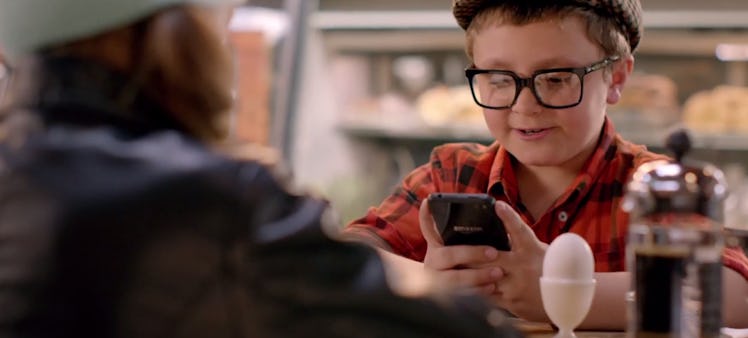How To Raise A Digitally Savvy Kid While Limiting Screen Time
Get the whole family in line, online.

Your kid is part of a whole generation that can swipe right before they can write. And because of that fact, you’ve become a little paranoid with how they interact with technology. It’s one thing to curb screen time, cut off the Wi-Fi, or investigate the feasibility of becoming Amish. But instead of taking their tech away (or just running away), why not just teach them how to use all of it responsibly and for their benefit?
Devorah Heitner, author of Screenwise: Helping Kids Thrive (and Survive) in their Digital World and the blog RaisingDigitalNatives.com, says it’s totally possible to teach young kids how to apologize to someone without emoji, deal with cyberbullies, and find a better use for YouTube than creepy unboxing videos. Here’s some of the practical screen etiquette for plugged-in youth that she’s been preaching in paper books and IRL seminars.
RELATED: New Data Points to Benefits of Moderate Screen Time
How To Be A Technology Role Model
Heitner says, whether you realize it or not, you are always modeling how someone should behave with a screen. Right now, while you’re reading this, your kids are watching (just be cool). Any time you’re phubbing the real human beings in the room, your kids are making a mental note. So, if you expect them to quit an app when you ask — you first. Here’s how to engage:
- No tech at the table. “They see when you bring your phone to the table,” says Heitner. “If we’re sitting down to dinner, I don’t have my phone on the table; it’s not there at all.”
- Close your laptop when you’re talking. “It acknowledges how these things take our attention,” she says. If your eyes are on the screen instead of the person you’re talking to, it’s a pretty obvious social cue that scrolling through your Facebook feed is more important right now.
- Get your kids to press pause. Part of you may want to yank the power cord out of the wall. The more appropriate part of you should start by asking them to pause the game or show and give you their full attention until further notice. If that fails, then it’s time to start ripping out cables.
Show Kids Your Texts
Ten is the average age children get smartphones, and Heitner says that you need to be the user guide. That’s because while your kids have seen you get incoming texts for years, they have no idea what could be so important. Show them what’s appropriate for texting. Explain what kind of information gets sent via text (“Honey, where’s my phone?”) and what things should be said in person (“Honey, I just took a job in California. Tell the kids.”). “When something is big or serious or emotional, we have to move face to face,” says Heitner.
Teach Kids to Apologize Offline
They might think that what happens anonymously online stays anonymously online. Heitner says you have to let kids know that real-life amends must be made — if possible. If they’ve trolled somebody on Minecraft, that person is probably thousands of miles away. But if they send a nasty text about a classmate, it’s time to do the right thing. “It can be really hard to resolve these things otherwise,” she says.
Make The Car a Screen-Free Zone
The only thing more terrifying than the thought of them driving, is them texting and driving. As mentioned earlier, it’s not enough to tell your kids “Do as I say, not as I do.” Your 4-year-old is observing how you weave through traffic while searching for more kindie bands on Spotify. You need to cut that shit out. “A lot of kids also complain about [their parents making them text for them while driving],” says Heitner. Oddly, they’d rather talk to you in the car, not take some dictation like some Mad Men secretary.
Raise Creators, Not Just Consumers
Heitner says it’s easy to forget the Internet isn’t just a place to consume content until your eyeballs dry out (that’s what content is designed to do, after all). Show them there’s a better, more productive online life they can have. It’s one they can actually learn useful, mind-expanding things — and not just where that Weedle is hiding.
There are a lot of resources out there to get your kids into the maker movement and have them share their work. “It’s very empowering,” she says. If they’re not already fans, have them check out Sylvia’s Super-Awesome Maker Show! It’s an online science show hosted by a girl who, at the age of 10, went viral and got an award from President Obama just for building some “glowy-eyed cuddle monsters.” (Not a pet-name for congressmen, by the way.)
Online Advertising Is Coming For Your Children
You want children to look out for the predators and creeps online. According to Heitner, there are other, more subtle a-holes preying your kid. Check your phone to make sure they’re not being hit up for credit card numbers, email, and physical addresses while they’re playing that new app. She says free app store games are notorious for embedded purchase options.
“Kids don’t have a lot of financial literacy in the digital world,” she says. “Many parents have been bitten in the butt by in-app purchases.” The first defense is to password protect all purchases. But if they do happen to buy something without you knowing, Heitner says you need to get them to tell you. She says you should frame your talk by saying that corporations want our money, but we have to be careful which ones get it. “Kids love to feel like a smart consumer,” she says. Adults, on the other hand, created the Mac n’ Cheetos.
This article was originally published on